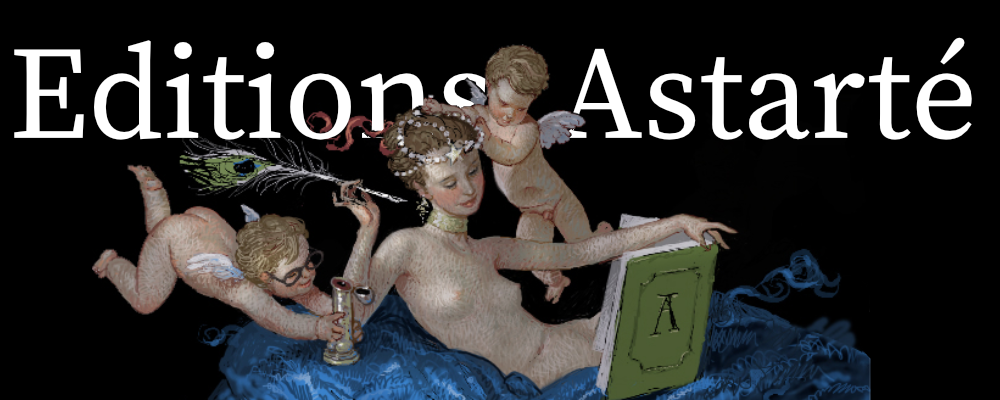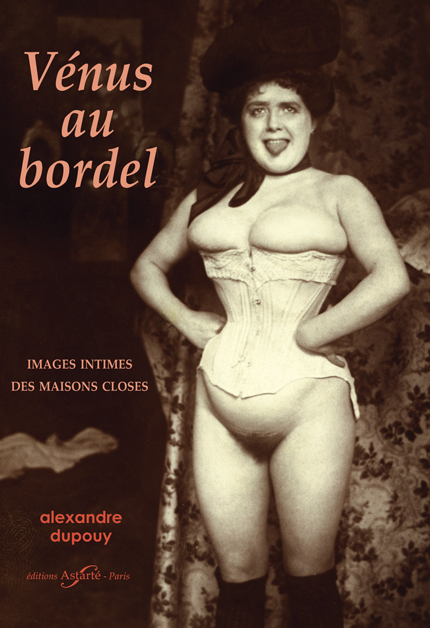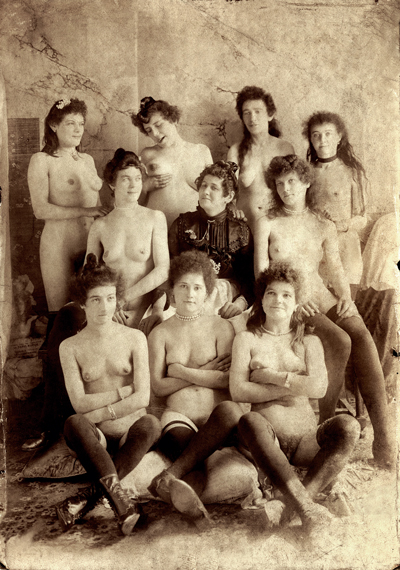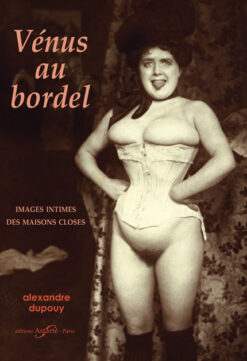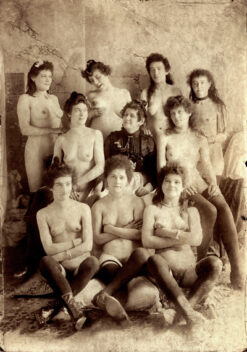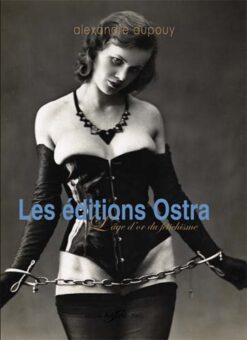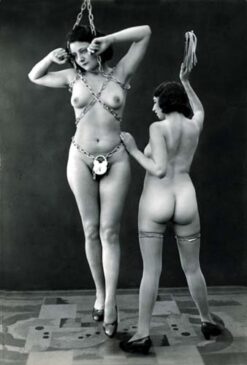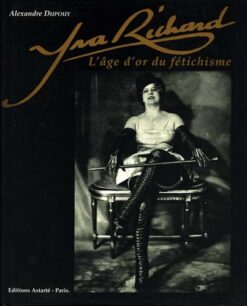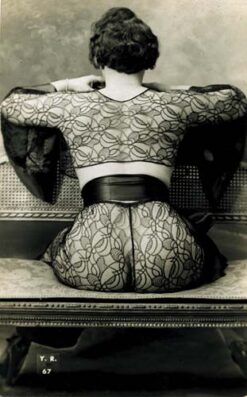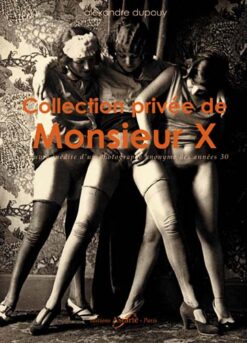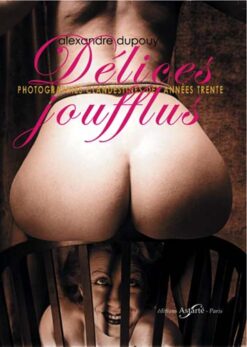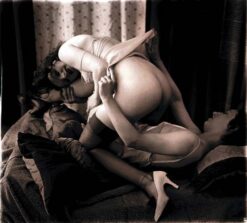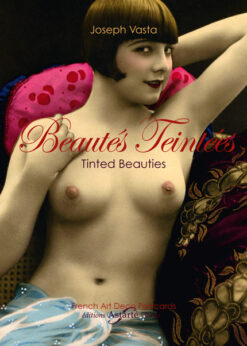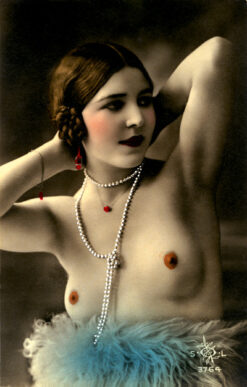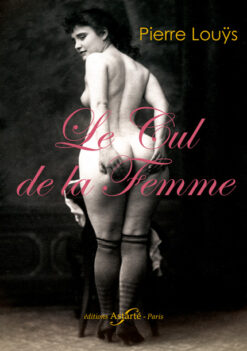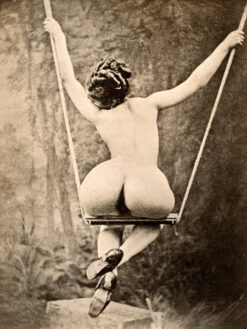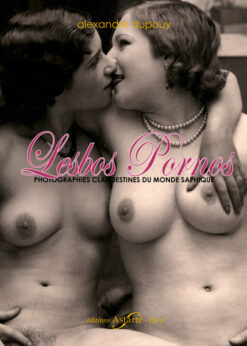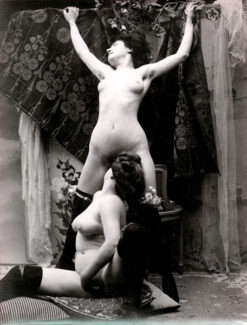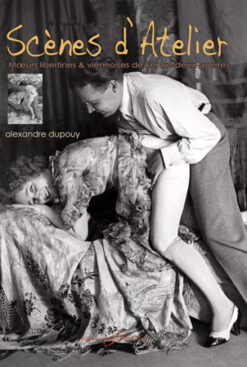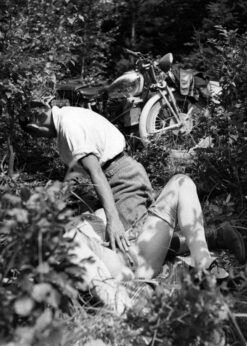VÉNUS AU BORDEL
22,00 €
Présenté par Alexandre DUPOUY
Un des 1000 exemplaires brochés, 96 pages (16,5 x 24) – 240 illustrations en noir et blanc
Pour tenter de percer le mystère de sa condition, nous pouvons toutefois compter sur elle et son caractère singulier. Elle nous laisse comme fil d’Ariane quelques photographies où elle accepte de s’offrir, non pas dans la déchéance vers laquelle les moralisateurs voudraient la cantonner, mais étalant, outrageante et rayonnante, ses particularités au sein de l’éternel féminin. Parfois, l’après-midi, avant l’affluence de l’amour vénal qui se consomme plutôt à la nuit, elle accède à la requête de rares photographes amateurs, moyennant une rétribution conséquente, plus proche de celle des spécialités qu’elle maîtrise que du dépucelage d’un potache. Là, elle s’exécute, mais aussi propose, se révélant souvent provocante et parfois maladroite. L’image ainsi conçue ne circulera pas. Si elle n’est pas destinée à servir la maison, elle restera confinée au fond du second rayon d’une bibliothèque bourgeoise et dans le secret d’une complicité unique, née entre la fille et son voyeur. Pour la plupart, ces photographies n’existent qu’en un seul exemplaire, et sont découvertes de façon épisodique et hasardeuse Néanmoins, tout chercheur, tout collectionneur, poursuit inlassablement son Graal. Dans une quête aussi captivante…
Extrait de la préface d’Alexandre Dupouy
—
VÉNUS AU BORDEL
Présenté par Alexandre DUPOUY
Un des 1000 exemplaires brochés, 96 pages (16,5 x 24) – 240 illustrations en noir et blanc
English translation inside
VENUS IN THE BROTHEL
Who lies within this brothel: a Pandora’s box giving free rein to every fantasy? Or more precisely, the objects of fantasies… those of the young virgin who must overcome his clumsiness to become a fully-fledged man? Or indeed the old pervert attempting to rekindle his ardour using subterfuges when he is only fooling himself? It would seem that these two extremes come together there, amongst a great many others.
But how can this mystery be unravelled nowadays without falling victim to apparent certainties? French law closed down the “maisons closes” from 1946 – a tautology, quipped the actress Arletty at the time – but did nothing to address the multitude of questions posed by the workings of mercenary love. Today three generations have never experienced the activities of brothels, which were managed by various secular institutions whose official publications -we are referring solely to French territory here- date back to St. Louis (1214-1270).
This lack of experience and visibility opens the door to all sorts of misinterpretations. However, the documentation exists. For anyone researching the life of brothels from 1870-1940 -the decades covered by the photographs in this book- hundreds of publications are available constituting an extremely thorough inventory. It brings together -each in their respective camps- the “romantics”, Pierre Mac Orlan, Francis Carco; the Puritans, René Bérenger, Émile Pourésy; the hard-core nostalgics, Michel Simon, Alphonse Boudard; the abolitionists, Marthe Richard, Josephine Butler; or the advocates for regulation with Alexandre Parent-Duchâtelet serving as mentor. They all want to be -or might- be right, but no one is seeing or talking about the same thing. The issue must be much more complex than it seems. The declarations of various studies on prostitution, often in the form of advocacy or indictments, are so conflicting that it is impossible to get a fair idea without likewise taking sides. Courtesans or human chattel? Receptacles for semen or enchantresses of the male elite? Incendiary communards or maltreated innocents? The 19th century prostitute gives rise to many enigmas.
In an attempt to unravel the mystery of her condition, we can nevertheless rely on the figure herself and her singular character. She has bequeathed us some photographs comparable to Ariadne’s thread, wherein she consents to offer herself up, not in the degradation to which the sanctimonious would confine her, but outrageous and radiant, magnifying her characteristics within the eternal feminine.
Occasionally in the afternoons, before the influx of mercenary sex more typically consumed at nighttime, she would humour the requests of very occasional amateur photographers in return for substantial remuneration. Closer to the specialties she mastered than the deflowering of schoolboys. She performs, but also proposes, often revealing herself as provocative and occasionally clumsy. Images thus conceived were not for circulation. If they were not intended for use in the establishment, they would remain hidden away on the bottom shelf of a bourgeois bookcase, in the secrecy of an exclusive complicity born between the girl and her voyeur.
Most of these photographs exist only in a single copy and finds are infrequent and haphazard. Nevertheless, any researcher or collector tirelessly pursues their grail. In a quest as entrancing as that of King Arthur’s knights -and just as legendary- the belief still endures of finding “The Album” on some divine day of clemency. The mythical “Album» -the subject of circulating rumours- would probably have been exhibited at the reception before the madam, and perused by waiting customers in good establishments. Elegantly bound, it would unashamedly exhibit indulgent photographs of girls, inaccessible for the time being because momentarily busy upstairs. Could this type of album really exist? It is doubtful, but the dream is an integral part of any search. The set of photographs at the beginning of chapter “Années trente“, for example, suggest that it could have been a presentation aid, made somewhat chaotic by the different choices of formats and the uneven quality of images. Some informed connoisseurs of the history of photography will notice that despite the relevance of his work, we have chosen not to illustrate this book with the photographs produced by Monsieur X. We refer interested parties instead to two monographs on this major artist in the world of prostitution -Collection privée de Monsieur X1 or Mauvaises filles2- as well as the book Joyeux Enfer3, in which he is accorded the proper recognition. Also for the attention of scholars, we have enhanced our collection with the addition of some advertisements, business cards or tokens, some of which come from a large collection found in poor condition. Notwithstanding the poor condition, it is worthy of great interest upon closer inspection as it consists of letters, advertisements and business cards most of which involve brothels or appointments. Moreover, the documents are commented, which is rather rare. This set was probably established by a Briton living in Paris, intended for his compatriots on holiday in our capital. Obviously, it is quite antiquated nowadays to learn that the house of “Madame Andrée Desprez, hotel, 14 Rue Lord-Byron” is a “dangerous house”, or that “Madame Delisy, a pretty pied à terre in a mansion at 31 Cité d’Antin” was “investigated and recommended” on “4 November, 1909”, but this record allows us to appreciate the diversity of supply, with the need for guides proving as indispensable in this area as in any other. Indeed, guides on prostitution did exist, such as the Guide Murier ou Guide Rose. But these specifically professional publications -meaning that they were neither intended for nor sold to patrons- were already rare during the period and even more so today, which complicates any in-depth research.
So that leaves these photographs where the fille de joie (good-time girl) responds, by her own arts, to artists -with Félicien Rops and Henri de Toulouse-Lautrec at the forefront- as well as men of letters -Guy de Maupassant, Emile Zola, Edmond and Jules Goncourt etc.- unveiling therein the truth of her condition.
Or at least one of its aspects, when she gives her self equally in luxury or misery, with excesses as pronounced for one as the other. Rebel incarnate, she demonstrates, more than any study, that she is a human being, even in her marginality, and that every attempt at classification to resolve the questions she raises will be in vain.
After all, the problem of prostitution may well lie outside the brothel, but this great debate has no place in a book of images. Its role is merely to show, so that once again everyone may form his or her own view.
1. Collection privée de Monsieur X, Paris, éditions Astarté, 2007.
2. Mauvaises filles, Paris, La Manufacture de livres, 2014.
3. Joyeux Enfer, Paris, La Musardine, 2014.
4 in stock

 Français
Français